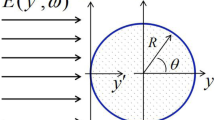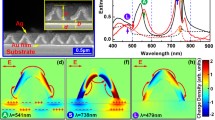Abstract
This work reports on the plasmonic properties of an eccentric nanostructure consisting of a silver ring and a gold disk, in the frequency regime of several hundreds of tetrahertz. In the structure, a gold nanodisk is located in a silver nanoring, with the centers of the two metals being set apart. As the radius of the gold disk, the separation between the centers, the light polarization, and the refractive index of the surrounding dielectric material are respectively varied, the normalized scattering cross section of the system is numerically simulated, using the finite difference time domain method. Multiple plasmonic resonances are observed, the plasmonic coupling effect between the ring and the disk is revealed, and the corresponding electromagnetic field distributions are demonstrated. The resonance peak associated with the coupling is found to possess a Fano-like lineshape, and it is well fitted to a model that employs a Fano function. The resonance frequency, the spectral width, and the characteristic q factor are determined from the best-fit parameters, and the plasmonic characteristics of the eccentric nanostructure are quantitatively probed. The results in this work may be of significance in designs of plasmonic devices that are based on bi-metallic eccentric structures.










Similar content being viewed by others
Data Availability
No datasets were generated or analysed during the current study.
References
Ozbay E (2006) Plasmonics: merging photonics and electronics at nanoscale dimensions. Science 311:189–193
Mejía-Salazar JR, Oliveira ON Jr (2018) Plasmonic biosensing. Chem Rev 118:10617–10625
Lee C, Lawrie B, Pooser R et al (2021) Quantum plasmonic sensors. Chem Rev 121:4743–4804
Pastoriza-Santos I, Kinnear C, Pérez-Juste J et al (2018) Plasmonic polymer nanocomposites. Nat Rev Mater 3:375–391
Kim PSY, Sternbach AJ, Choi MS et al (2023) Ambipolar charge-transfer graphene plasmonic cavities. Nat Mater 22:838–843
Chen S, Kang ESH, Chaharsoughi MS et al (2020) Conductive polymer nanoantennas for dynamic organic plasmonics. Nat Nanotechnol 15:35–40
Mousavi NSS, Ramadi KB, Song YA et al (2023) Plasmonics for neuroengineering. Communications Materials 4:1–16
Peña-Rodríguez O, Pal U (2011) Enhanced plasmonic behavior of bimetallic (Ag-Au) multilayered spheres. Nanoscale Res Lett 6:279
Peña-Rodríguez O, Díaz-Núñez P, González-Rubio G et al (2020) Au@Ag Core-shell nanorods support plasmonic Fano resonances. Sci Rep 10:5921
Zhu J, Li JJ, Zhao JW (2015) The effect of dielectric coating on the local electric field enhancement of Au-Ag core-shell nanoparticles. Plasmonics 10:1–8
Gu G, Li L, Zhang Y et al (2017) Analysis of mutual couplings in a concentric circular ring plasmonic optical antenna array. Sci Rep 7:10996
Peña-Rodríguez O, Díaz-Núñez P, Rodríguez-Iglesias V et al (2017) Near-and far-field optical response of eccentric nanoshells. Nanoscale Res Lett 12:16
Ivanchenko M, Nooshnab V, Myers AF et al (2022) Enhanced dual plasmonic photocatalysis through plasmonic coupling in eccentric noble metal-nonstoichiometric copper chalcogenide hetero-nanostructures. Nano Res 15:1579–1586
Sun JS, Wang JD, Zhang Y et al (2014) Shape evolution of Au nanoring@Ag core-shell nanostructures: diversity from a sole seed. Dalton Trans 33:12495–12500
Fano U (1961) Effects of configuration interaction on intensities and phase shifts. Phys Rev 124:1866–1878
Miroshnichenko AE, Flach S, Kivshar YS (2010) Fano resonances in nanoscale structures. Rev Mod Phys 82:2257–2297
Luk’yanchuk B, Zheludev NI, Maier SA et al (2010) The Fano resonance in plasmonic nanostructures and metamaterials. Nat Mater 9:707–715
Zhang Q, Wen X, Li G et al (2013) Multiple magnetic mode-based Fano resonance in split-ring resonator/disk nanocavities. ACS Nano 7:11071–11078
Khan AD, Khan SD, Khan R et al (2014) Generation of multiple Fano resonances in plasmonic split nanoring dimer. Plasmonics 9:1091–1102
Gu JX, Dong DD, Xiong T et al (2022) Investigation of the Fano lineshapes in plasmonic asymmetric silver nanosphere dimer. Opt Quant Electron 54:447
Zhang Y, Xiong T, Dong DD et al (2023) Plasmonic characteristics of rhodium dual broken nanorings in UV-visible regime. Appl Phys B 129:60
FDTD Solutions, www.lumerical.com
Palik ED (1998) Handbook of optical constants of solids, Vol.3, Academic Press
Johnson PB, Christy RW (1972) Optical constants of the noble metals. Physics Review B 6:4370
Zhang TH, He JY, Xie W et al (2020) Plasmonic properties of a honeycomb structure formed by metallic nanoparticles. Physica E 118:113901
Zhang Y, Xiong T, Dong DD et al (2023) Plasmonic characteristics of the graphene-photonic crystal composite structure in the IR regime. Plasmonics 18:125–135
Funding
This study was funded by the Education Department Basic Scientific Research Project of Liaoning Province of China (grant no. LJKQZ2021171).
Author information
Authors and Affiliations
Contributions
All authors contributed to the study conception and design. Software, analysis and figures were performed by Xinyu He. Methodology and investigation by Cheng Sun. The original draft of the manuscript was written by Xinyu He and Cheng Sun. All authors read and approved the final manuscript.
Corresponding author
Ethics declarations
Ethics Approval
Not applicable.
Consent to Participate
All authors agreed to participate in this research.
Consent for Publication
Permission from all the authors has been taken to publish this manuscript.
Competing Interests
The authors declare no competing interests.
Additional information
Publisher's Note
Springer Nature remains neutral with regard to jurisdictional claims in published maps and institutional affiliations.
Rights and permissions
Springer Nature or its licensor (e.g. a society or other partner) holds exclusive rights to this article under a publishing agreement with the author(s) or other rightsholder(s); author self-archiving of the accepted manuscript version of this article is solely governed by the terms of such publishing agreement and applicable law.
About this article
Cite this article
He, X., Sun, C. On the Plasmonic Properties of a Bi-Metallic Eccentric Ring-Disk Nanostructure. Plasmonics (2024). https://doi.org/10.1007/s11468-023-02184-2
Received:
Accepted:
Published:
DOI: https://doi.org/10.1007/s11468-023-02184-2




